Galaxy S22 Ultra vs. iPhone 13 Pro Max: Which phone is best?
Can the Note-infused S22 Ultra take down Apple’s biggest and best?

The recently unveiled Samsung Galaxy S22 Ultra borrows from the best of the Galaxy Note and Ultra lines, but is it enough to unseat the iPhone 13 Pro Max as the top high-end flagship on the market? The Galaxy S22 Ultra vs. the iPhone 13 Pro Max is the question that will be on the minds of many seeking flagship smartphone nirvana this year, so let’s figure out which comes out on top.
The Galaxy S22 Ultra offers some features that Apple fails to match with the integrated S Pen, an incredible 10x zoom and 45W fast charging. Apple naturally has some aces up its sleeve with an f/1.5 wide-angle and f/1.8 ultra-wide camera that are the envy of the rest of the smartphone world and powering it all is Apple’s unmatched A15 Bionic processor.
While these titanic phones offer some clear advantages over one another in certain categories, it’s hashing out the grey areas that will help us find the answer to who wins in the face-off of the Galaxy S22 Ultra vs. iPhone 13 Pro Max.
- Best smartphones in 2022
- Best budget phones in 2022
- Best mobile phone deals in February 2022
Galaxy S22 Ultra vs. iPhone 13 Pro Max: price and value
The Galaxy S22 Ultra starts at $1,199 for the 128GB model with 8GB of RAM. Upgrading to 256GB, 512GB or 1TB for $1,299, $1,399 and $1,599 respectively also bumps you up to 12GB of RAM.
The iPhone 13 Pro Max starts at $1,099 for a 128GB model with 6GB of RAM. You can upgrade to 256GB, 512GB or a new 1TB option. It’s an extra $100 for the 256GB model, which is necessary for the new ProRes video feature if you are a mobile cinematographer. Add another $200 for the 512GB and 1TB options, maxing the phone out at $1,599.
During the pre-order period for the Galaxy S22 Ultra (through February 24) you get a free upgrade to the next storage tier, making the 256GB model just $1,199, matching up exactly with the iPhone 13 Pro Max pricing. However, it’s not fair to factor that in the long term for this category, so for perhaps the first time ever, the price and value win goes to an iPhone.
Winner: iPhone 13 Pro Max
Stay in the know with Laptop Mag
Get our in-depth reviews, helpful tips, great deals, and the biggest news stories delivered to your inbox.
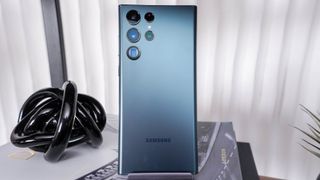
Galaxy S22 Ultra vs. iPhone 13 Pro Max: design
Both of these phones boast a unique look and while the tide of boring slabs has ebbed slightly in the last couple of years, it’s still a welcome sight. The iPhone 13 Pro Max follows the squared-off aesthetic Apple brought back with the iPhone 12, while the Galaxy S22 Ultra gives us the Galaxy Note 20 Ultra redux.
The S22 Ultra is just a bit shorter than the Note 20 Ultra due to its 6.8-inch display (versus 6.9-inch), but it is otherwise a dead ringer from most angles for what I said was a “gorgeous smartphone” when I reviewed it in 2020 and time hasn’t changed that a bit. The curved edges of the S22 Ultra feel fantastic when holding the phone and the flat top and bottom contrast nicely for added visual appeal. The burgundy matte finish on the back of the phone is luxurious. My one qualm about the S22 Ultra design is the exposed camera lenses on the back. It’s going to take more time with the phone to see if it bothers me, but I feel like it may be a step back from the Contour Cut Camera housing Samsung introduced last year.

The iPhone 13 Pro Max design doesn’t have quite the same flourish. Still, it’s unmistakable for any other phone and the glass and stainless steel finish unquestionably give it the premium aesthetic you would hope for on a $1,100+ phone. The notch remains the bane of the iPhone design. Do you stop noticing it? Yes, you do. Does that make it less ugly? Absolutely not.
Both of these phones are behemoths. The iPhone 13 Pro Max is overall smaller at 6.3 x 3.1 x 0.3 inches compared to 6.4 x 3 x 0.35 inches for the Galaxy S22 Ultra. However, the S22 Ultra is slightly narrower and lighter at 8.1 ounces to the 13 Pro Max’s 8.5 ounces.
The Galaxy S22 Ultra takes this one. The curved edges, narrower body and lighter weight make it a more comfortable device to use and while both designs are stunning in their own right, the S22 Ultra has a certain opulence to its design that the iPhone 13 Pro Max can’t match.
Winner: Galaxy S22 Ultra
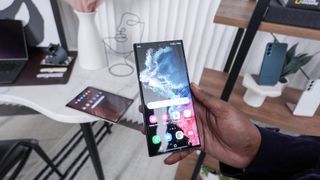
Galaxy S22 Ultra vs. iPhone 13 Pro Max: display
The iPhone 13 Pro Max features a 6.7-inch Super Retina XDR OLED display with ProMotion and a 2778 x 1284-pixel resolution. The Galaxy S22 Ultra 1-ups it at 6.8 inches, but the Dynamic AMOLED 2X display buries it when it comes to resolution at WQHD+ (3200 x 1440). Samsung also claims the adaptive refresh rate crown, scaling from 1Hz to 120Hz, compared to the iPhone’s 10Hz up to 120Hz range.
Samsung’s other big claim with the S22 Ultra display is a jump to an incredible 1,750 nits of peak brightness; if true, that would dramatically outperform the 837 peak brightness for the iPhone 13 Pro Max. We are running the Galaxy S22 Ultra through our gamut of color, accuracy and brightness testing and will update this section once that is complete.
While the iPhone may find a way to win this one, it is doubtful that Samsung is simply not challenged in the mobile display space. This is why Apple and many of Samsung’s high-end competitors use Samsung displays. Based on its track record and the advantages we already know it has, the win goes to the Galaxy S22 Ultra.
Winner: Galaxy S22 Ultra
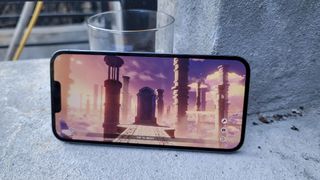
Galaxy S22 Ultra vs. iPhone 13 Pro Max: performance
The Galaxy S22 Ultra is the first phone to launch in the U.S. with the new Snapdragon 8 Gen 1 processor. We are still in the testing process for our review, so you’ll need to return for the final ruling on this one. With that said, there is roughly the same chance of it beating the A15 Bionic in the iPhone 13 Pro Max as me being struck by lightning in my basement as I type this…nope, I’m safe and so is the A15 Bionic’s dominance. Despite offering double the iPhone 13 Pro Max’s RAM (12GB vs. 6GB), there’s just no way to outmuscle Apple’s chips at the moment.
However, as I’ve made it clear in my last several reviews, flagship phones are more powerful than we need them to be currently. After roughly 24 hours with the Galaxy S22 Ultra, I can confidently state that you aren’t going to come up with a task that it can’t handle. Needless to say, that goes double for the iPhone 13 Pro Max. Load it up with Google Chrome tabs, switch between dozens of apps while watching picture-in-picture videos or max out the settings on PUBG or Genshin Impact and you won’t get a dropped frame.
There are some limited scenarios where you still see a difference today. The iPhone 13 Pro Max delivers incredible video processing speeds, cruising through our Adobe Premiere Rush video editing test in 25.1 seconds. While again, we don’t have the results from the Galaxy S22 Ultra yet, its predecessor completed that task in 1 minute and 3 seconds; the Snapdragon 8 Gen 1 is an improvement, but it’s not going to shave the result by more than half.
The more relevant factor is long-term performance. All of that extra headroom that the iPhone 13 Pro Max has with the A15 Bionic should keep the phone chugging along happily for years. The Galaxy S22 Ultra won’t be slowing to a crawl in a couple of years either, but there’s no question it will show its age sooner. If you upgrade your phone once every 4-5 years or more, that’s worth considering.
While both phones offer excellent performance: the iPhone 13 Pro Max retains its performance crown.
Winner: iPhone 13 Pro Max
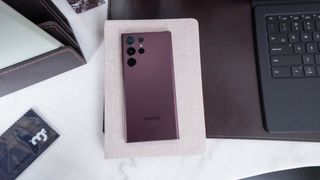
iPhone 13 Pro Max vs. Galaxy S21 Ultra: battery life and charging
Big phones should come with big batteries and neither disappoints in this regard. The Galaxy S22 Ultra has the size edge with a 5,000 mAh battery compared to the 4,352 mAh battery in the iPhone 13 Pro Max. However, we are still testing the Galaxy S22 Ultra to see whether that physical advantage results in superior battery life.
It will be a challenge for Samsung as the iPhone 13 Pro Max offers the longest-lasting battery of any iPhone. In our Laptop Mag battery test, it managed 12 hours and 16 minutes of continuous web surfing on 5G with the screen set to 150 nits of brightness.
While we await the results, charging is a much more cut-and-dry matter with Samsung stepping up its game this year with support for 45W fast charging, obliterating the paltry 23-27W that the iPhone 13 Pro Max offers. While the smaller battery in the iPhone 13 Pro Max means this won’t mean half the charging time for the Galaxy S22 Ultra, there’s no question this is a win for Samsung.
Both phones support wireless charging with Qi compatibility and Apple’s proprietary MagSafe charging. Speeds are considerably slower, topping out at 15W, but as a wireless charging convert that has littered his house with Qi charging stands and pucks, I find the convenience to be worth the speed trade-off for daily use.
Until the lab and real-world test results for the Galaxy S22 Ultra come in, this is a draw as the Galaxy S22 Ultra has a significant charging advantage, but I don’t like its chances to outlast the iPhone 13 Pro Max on a charge.
Winner: Draw
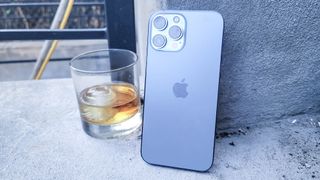
Galaxy S22 Ultra vs. iPhone 13 Pro Max: cameras
While the Galaxy S22 Ultra had several updates to its hardware, the rear camera array remains the same. While it was unquestionably one of the best camera setups of 2021 and remains a strong contender, the iPhone 13 Pro Max made significant moves last year that spell trouble for the S22 Ultra when we take these two out for testing.
The fact that all four iPhone 13 Pro Max sensors are just 12MP may sound disappointing, but don’t let that fool you; they are some of the best sensors on the market. The wide-angle is the fastest we’ve seen at f/1.5 and the ultra-wide at f/1.8 is on par with Samsung’s primary and that of many other flagships. The telephoto was the one mixed upgrade for the 13 Pro Max with a jump to a 3x optical zoom, up from 2.5x, but a somewhat precipitous drop to an f/2.8 aperture from f/2.0. The front-facing camera at f/2.2 remains one of the best in the industry for portrait selfies, thanks to the extra depth-sensing tech in the notch. Sensor-shift optical image stabilization enhances what would already be impressive low-light performance from those sensors.
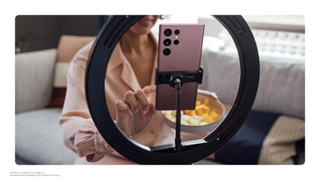
The Galaxy S22 Ultra truly is a copy and paste of the S21 Ultra cameras. That outlandish 108MP wide-angle sensor at f/1.8, a 12MP ultra-wide sensor at f/2.2, a 10MP 3x telephoto at f/2.4, and a 10MP telephoto at f/4.9 camera. Turning to the front, you have the scarily sharp 40MP front-facing camera at f/2.2. In terms of reach and versatility, even a year later, nothing touches these sensors, but unless you need that reach, there’s no question the iPhone 13 Pro Max has the spec advantage.
An important note here is that until we’ve done more extensive testing with the Galaxy S22 Ultra camera, we won’t know what impact the Snapdragon 8 Gen 1 has had on its photo processing. Computational photography can be more important than the hardware itself; look at how long Google propped up the weak Pixel cameras with its software, with enhanced AI and ML in the new processor Samsung may have leveled up without touching the camera sensors.
While there is something incredibly satisfying about the madness of a 10x (100x digital) zoom on a phone, the win should easily go to the iPhone 13 Pro Max. Its advantages in low light with its primary and ultra-wide are more likely to deliver some photos that you would have missed on the S22 Ultra than the added telephoto reach.
Winner: iPhone 13 Pro Max

iPhone 13 Pro Max vs. Galaxy S21 Ultra: software
As per usual, this won’t be a discussion of iOS versus Android; each one has its advantages and disadvantages. Adapting to one or the other can take a week or two and there are some lock-in components like iMessage that make switching a hassle, but overall there are more similarities than differences to the operating systems.
iOS 15 did bring some interesting new features to the iPhone, including freeing one previous lock-in feature, FaceTime, now available to Windows or Android users. Notification controls were also expanded greatly and enhancements to Apple Maps, and the new more robust Photos app makes it a stronger competitor for Google Photos. While the Galaxy S22 Ultra uses Samsung’s One UI 4.1 overlay on Android 12, it comes with many of the same benefits, including a visual overhaul, the new notification panel, privacy updates and a host of handy additions like universal search.
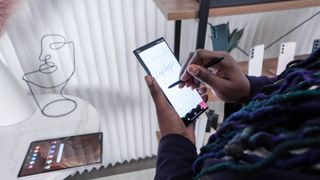
Samsung does have a few notable software features that could sway some power users. The first is the S Pen support; if you want a stylus with your phone, then this conversation is all over. Another potential game-changer for some is Samsung’s DeX mode which essentially turns your phone into a laptop replacement. The latter is one of the few features that actually uses all of the pent-up power available in this superphone.
Perhaps the biggest differentiator in software between these phones remains support. While Apple doesn’t have a specific support commitment, it consistently offers at least 5 to 6 years of support for its flagship phones.The Galaxy S22 Ultra, by comparison, will get four major Android updates and four years of security updates. While Google’s Pixel receives an extra year of security updates, Samsung now leads the Android market in major OS updates.
I’m calling this category a draw. While Apple still has the support lead, at four years, Samsung has mitigated that advantage and some of Samsung's more advanced software features like DeX eclipse anything the iPhone can offer.
Winner: Draw
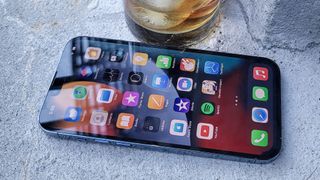
Galaxy S22 Ultra vs. iPhone 13 Pro Max: Outlook
Samsung might send this one into overtime if it delivers strong battery life in our testing and tips that category in its favor, but for now, the iPhone 13 Pro Max takes the slight edge in this face-off with three categories to Samsung’s two.
Except for Samsung’s display win and Apple’s camera victory, these categories are all extremely close among these phones. IOS versus Android may decide it for you if you are already heavily invested in either, but both phones are phenomenal from a hardware standpoint.
The Galaxy S22 Ultra offers some unique features like its S Pen, DeX and that incredible telephoto reach that make it an intriguing option for anyone bored with the same old smartphone features, no matter how well done. The iPhone 13 Pro Max for its part may just be those same old smartphone features but it’s done better than anyone else is doing it. For now, at least the 13 Pro Max continues its reign as “the new king of smartphones.”
Sean Riley has been covering tech professionally for over a decade now. Most of that time was as a freelancer covering varied topics including phones, wearables, tablets, smart home devices, laptops, AR, VR, mobile payments, fintech, and more. Sean is the resident mobile expert at Laptop Mag, specializing in phones and wearables, you'll find plenty of news, reviews, how-to, and opinion pieces on these subjects from him here. But Laptop Mag has also proven a perfect fit for that broad range of interests with reviews and news on the latest laptops, VR games, and computer accessories along with coverage on everything from NFTs to cybersecurity and more.

